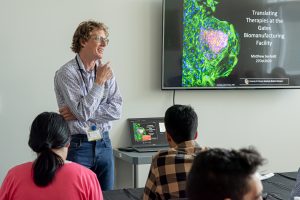Wellness
University Creates Innovative Model for Running a GMP Manufacturing Facility
Construction started on the manufacturing facility in 2015, and it opened with three employees. The facility now has 50 employees and has, to date, completed…

The University of Colorado has adopted an innovative model for running an academic GMP manufacturing facility without extensive endowment funding. The Charles Gates Biomanufacturing Facility is one of only a few GMP facilities able to manufacture cell- and protein-based therapies for both academic researchers and industry.
This hybrid model, serving industry and academia, was a response to the need for funding, according to facility director Matthew Seefeldt, PhD.
“Cell therapy is hard, and problem-solving requires GMP experience and creativity,” he says. “Academic centers have provided value in this space, but the University of Colorado didn’t have a huge endowment to build this kind of facility that needs millions of dollars to run.”
The solution was to build a facility that served academic and industry customers—both large and small—with Nkarta being among its larger customers.
“We were able to get the NKX101 molecule into clinic while building out our GMP capabilities internally,” Seefeldt explains. “Our niche is to do hard things, and cell therapies are still hard, so we do take all comers on the Phase I side.”

Construction started on the manufacturing facility in 2015, and it opened with three employees, Seefeldt recalls. The facility now has 50 employees and has, to date, completed 100 GMP runs.
The team, which is recruited from the university or by external hiring work, with four to five clients at a time. Clients take between six months and “years” to file an Investigational New Drug (IND) application for their gene or cell therapy—depending on whether it’s a standard CAR-T cell therapy or uses a never-seen-before manufacturing process.
GMP manufacturing is carried out in a 25,000 foot2 facility, with 4,000 feet2 over to clean rooms and the rest devoted to warehousing, QC, and other functions.
According to Seefeldt, their model aims to help academic researchers who are struggling to make the jump from an incubator to commercial manufacture.
“There’s a valley of death where creative researchers need to understand the regulatory complexities of getting into the clinic as well as financing and investment,” he says. “We help them go through that.”
Giving advice for other universities hoping to establish similar facilities, he recommends considering the running costs—not just the upfront capital costs—and assessing who your customers will be and the manufacturing quality they require.
The University now plans to build on its success with the facility by using a $200 million philanthropic investment from the Gates Frontier Fund to establish a new institute.
The post University Creates Innovative Model for Running a GMP Manufacturing Facility appeared first on GEN – Genetic Engineering and Biotechnology News.

Lion’s Mane Mushroom: History, Benefits, and Adaptogen Properties
Explore the intriguing world of Lion’s Mane Mushroom in our comprehensive guide. Dive into its unique properties, historical significance, and myriad health…
AI can already diagnose depression better than a doctor and tell you which treatment is best
Artificial intelligence (AI) shows great promise in revolutionizing the diagnosis and treatment of depression, offering more accurate diagnoses and predicting…
Reasons You should Get this: Neptune Wellness Solutions Inc (NASDAQ:NEPT), WeTrade Group Inc. (NASDAQ:WETG)
NEPT has seen its SMA50 which is now -9.28%. In looking the SMA 200 we see that the stock has seen a -92.25%. WETG has seen its SMA50 which is …
The…













